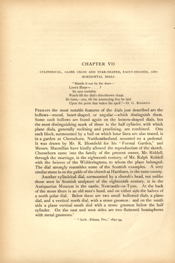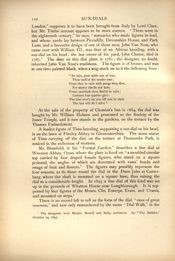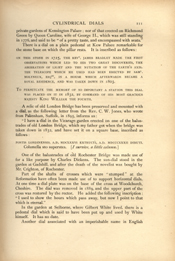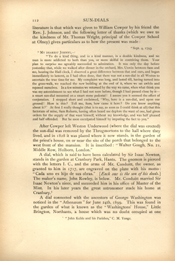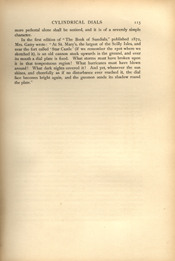CHAPTER VII
CYLINDRICAL, GLOBE CROSS AND STAR-SHAPED, FACET-HEADED, AND HORIZONTAL DIALS
|
"Stands it not by the door — Love's Hour — . . . ? Its eyes invisible Watch till the dial's thin-thrown shade Be born, — yea, till the journeying line be laid Upon the point that wakes the spell." |
| — D. G. ROSSETTI. |
PERHAPS the most notable features of the dials just described are the hollows — round, heart-shaped, or angular — which distinguish them. Some such hollows are found again on the lectern-shaped dials, but the most distinguishing mark of these is the half cylinder, with which plane dials, generally reclining and proclining, are combined. One such block, surmounted by a ball on which hour lines are also traced, is in a garden at Cheeseburn, Northumberland, mounted on a pedestal. It was drawn by Mr. R. Blomfield for his "Formal Garden," and Messrs. Macmillan have kindly allowed the reproduction of the sketch. Cheeseburn came into the family of the present owner, Mr. Riddell, through the marriage, in the eighteenth century, of Mr. Ralph Riddell with the heiress of the Widderingtons, to whom the place belonged. The dial strongly resembles some of the Scottish examples. A very similar stone is on the gable of the church at Hartburn, in the same county.
Another cylindrical dial, surmounted by a cherub's head, not unlike those seen in Scottish sculpture of the eighteenth century, is in the Antiquarian Museum in the castle, Newcastle-on-Tyne. At the back of the stone there is an old man's head, and on either side the halves of a north polar dial. Below these are two small hollowed dials, a plane dial, and a vertical north dial, with a stone gnomon; and on the south side a plane vertical south dial with a stone gnomon below the half cylinder. On the east and west sides are two flattened hemispheres with metal gnomons. 1
1 "Arch. Æliana, Pro.," 1891-94.
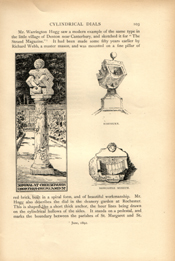
[Full Image]
SUNDIAL AT CHEESEBURN, NORTHUMBERLAND.
HARTBURN.
NEWCASTLE MUSEUM.
Mr. Warrington Hogg saw a modern example of the same type in the little village of Denton near Canterbury, and sketched it for "The Strand Magazine." 1 It had been made some fifty years earlier by Richard Webb, a master mason, and was mounted on a fine pillar of red brick, built in a spiral form, and of beautiful workmanship. Mr. Hogg also describes the dial in the deanery garden at Rochester. This is shaped like a short thick anchor, the hour lines being drawn on the cylindrical hollows of the sides. It stands on a pedestal, and marks the boundary between the parishes of St. Margaret and St.
1 June, 1892.
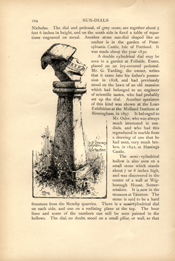
[Full Image]
In ye Deanery Garden, Rochester.
Nicholas. The dial and the pedestal, of grey stone, are together about 5 feet 6 inches in height, and on the south side is fixed a table of equations engraved on metal. Another stone sun-dial shaped like an anchor is in the garden of Pennsylvania Castle, Isle of Portland. It was made about the year 1830.
A double cylindrical dial may be seen in a garden at Fellside, Essex, placed on an ivy-covered pedestal. Mr. G. Yarding, the owner, writes that it came into his father's possession in 1828, and had previously stood on the lawn of an old mansion which had belonged to an engineer of scientific tastes, who had probably set up the dial. Another specimen of this kind was shown at the Loan Exhibition at the Midland Institute at Birmingham, in 1897. It belonged to Mr. Osler, who was always much interested in sun-dials, and who had this reproduced in marble from a drawing of one that he had seen, very much broken, in 1842, at Hastings Castle.
The semi-cylindrical hollow is also seen on a small stone which stands about 7 or 8 inches high, and was discovered in the centre of a wall at Wigborough House, Somersetshire. It is now in the museum at Taunton. The stone is said to be a hard freestone from the Mendip quarries. There is a semi-cylindrical dial on each side, and one on a reclining plane at the top. The hour lines and some of the numbers can still be seen painted in the hollows. The dial, no doubt, stood on a pillar, or wall, so that
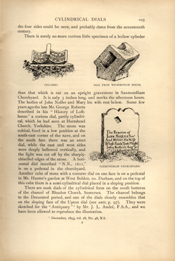
[Full Image]
FELLSIDE.
DIAL FROM WIGBOROUGH HOUSE.
SAXMUNDHAM CHURCHYARD.
the four sides could be seen, and probably dates from the seventeenth century.
There is surely no more curious little specimen of a hollow cylinder than that which is cut on an upright gravestone in Saxmundham Churchyard. It is only 3 inches long, and marks the afternoon hours. The bodies of John Noller and Mary his wife rest below. Some few years ago the late Mr. George Roberts described in his "History of Lofthouse" a curious dial, partly cylindrical, which he had seen at Hartshead Church, Yorkshire. The stone was cubical, fixed in a low position at the south-east corner of the nave, and on the south face there was an erect dial, while the east and west sides were deeply hollowed vertically, and the light was cut off by the sharply-chiselled edges of the stone. A horizontal dial inscribed "N.N., 1611," is on a pedestal in the churchyard. Another cube of stone with a concave dial on one face is on a pedestal in Mr. Hunter's garden at West Boldon, co. Durham, and on the top of this cube there is a semi-cylindrical dial placed in a sloping position.
There are sunk dials of the cylindrical form on the south buttress of the chancel of Bleadon Church, Somerset. The chancel belongs to the Decorated period, and one of the dials closely resembles that on the sloping face of the Upton dial (see ante, p. 97). They were sketched for the "Antiquary" 1 by Mr. J. L. André, F.S.A., and we have been allowed to reproduce the illustration.
1 December, 1893, vol. 28, No. 48, N.S.
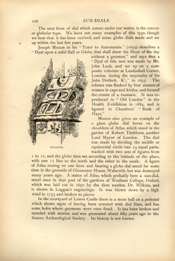
[Full Image]
BLEADON.
The next form of dial which comes under our notice is the convex or globular type. We have not many examples of this type, though we hear that it has been revived, and some globe dials made and set up within the last few years.
Joseph Moxon in his "Tutor to Astronomie" (1659) describes a "Dyal upon a solid Ball or Globe, that shall shew the Hour of the day without a gnomon," and says that a "Dyal of this sort was made by Mr. John Leek, and set up on a composite columne at Ladenhill Corner, London, during the mayoralty of Sir John Dethick, Kt.," in 1655. The column was flanked by four statues of women in caps and kirtles, and formed the centre of a fountain. It was reproduced in "Old London" in the Health Exhibition in 1884, and is figured in Chambers' "Book of Days."
Moxon also gives an example of a glass globe dial borne on the shoulders of Atlas, which stood in the garden of Robert Titchborn, another Lord Mayor of London. The dial was made by dividing the middle or equinoctial circle into 24 equal parts, marked with two sets of figures from 1 to 12, and the globe then set according to the latitude of the place, with one 12 line to the north and the other to the south. A figure of Atlas resting on one knee and bearing a globe dial stood for some time in the grounds of Gloucester House, Walworth, but was destroyed many years ago. A statue of Atlas, which probably bore a sun-dial, stood once in that part of the gardens of Wadham College, Oxford, which was laid out in 1650 by the then warden, Dr. Wilkins, and is shown in Loggan's engravings. It was blown down by a high wind in 1753 and broken to pieces.
In the courtyard of Lewes Castle there is a stone ball on a pedestal which shows signs of having been covered with dial lines, and has some holes where gnomons were once fixed. It has been broken and mended with mortar, and was presented about fifty years ago to the Sussex Archæological Society. Its history is not known.
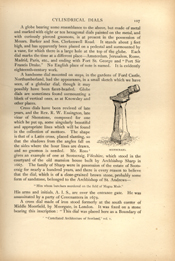
[Full Image]
SCOTSCRAIG.
A globe bearing some resemblance to the above, but made of metal and marked with eight or ten hexagonal dials painted on the metal, and with curiously pierced gnomons, is at present in the possession of Messrs. Barker and Son, Clerkenwell Road. It stands about 3 feet high, and has apparently been placed on a pedestal and surmounted by a vane, for which there is a large hole at the top of the globe. Each dial marks the time at a different place — Amsterdam, Jerusalem, Rome, Madrid, Paris, etc. and ending with Fort St. George and "Port Sir Francis Drake." No English place of note is named. It is evidently eighteenth-century work.
A handsome dial mounted on steps, in the gardens of Ford Castle, Northumberland, had the appearance, in a small sketch which we have seen, of a globular dial, though it may possibly have been facet-headed. Globe dials are sometimes found surmounting a block of vertical ones, as at Knowsley and other places.
Cross dials have been revived of late years, and the Rev. R. W. Essington, late vicar of Shenstone, composed for one which he put up, some singularly beautiful and appropriate lines which will be found in the collection of mottoes. The shape is that of a Latin cross, placed slanting, so that the shadows from the angles fall on the sides where the hour lines are drawn, and no gnomon is needed. Mr. Ross 1 gives an example of one at Scotscraig, Fifeshire, which stood in the courtyard of the old mansion house built by Archbishop Sharp in 1667. The family of Sharp were in possession of the estate of Scotscraig for nearly a hundred years, and there is every reason to believe that the dial, which is of a close-grained brown stone, probably some form of sandstone, belonged to the Archbishop of St. Andrews —
"Him whom butchers murdered on the field of Magus Muir."
His arms and initials, A. I. S., are over the entrance gate. He was assassinated by a party of Covenanters in 1679.
A cross dial made of iron formerly stood at the south corner of Middle Moorfield, by Moorgate, in London. It was fixed on a stone bearing this inscription: "This dial was placed here as a Boundary of
1 "Castellated Architecture of Scotland," vol. v.
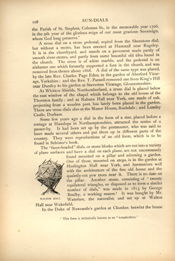
[Full Image]
WALTON HALL.
the Parish of St. Stephen, Coleman St., in the memorable year 1706, in the 9th year of the glorious reign of our most gracious Sovereign, whom God long preserve."
A cross dial on a stone pedestal, copied from the Shenstone dial, but without a motto, has been erected at Hamstall near Rugeley. It is in the churchyard, and stands on a pavement made partly of smooth river-stones, and partly from some beautiful old tiles found in the church. The cross is of white marble, and the pedestal is an alabaster one which formerly supported a font in the church, and was removed from thence about 1868. A dial of the same type was placed, by the late Rev. Charles Page Eden, in the garden of Aberford Vicarage, Yorkshire; and the Rev. T. Parnell removed one from King's Hill near Dursley to his garden at Staverton Vicarage, Gloucestershire.
At Whitton Shields, Northumberland, a cross dial is placed below the east window of the chapel which belongs to the old house of the Thornton family; and at Naburn Hall near York, one made of oak, projecting from a wooden post, has lately been placed in the garden. There are cross dials also at the Manor House, Rochdale; and Lumley Castle, Durham.
Some few years ago a dial in the form of a star, placed before a cottage at Hanslope in Northamptonshire, attracted the notice of a passer-by. It had been set up by the postmaster, who was said to have made several others and put them up in different parts of the country. They were reproductions of an old form, which is to be found in Schöner's book.
The "facet-headed" dials, or stone blocks which are cut into a variety of plane surfaces and have a dial on each plane, are not uncommonly found mounted on a pillar and adorning a garden. One of these, mounted on steps, is in the garden at Heslington Hall near York, and harmonizes well with the architecture of the fine old house and the quaintly-cut yew trees near it. There is no date on the pillar. Another stone, consisting of "twenty equilateral triangles, so disposed as to form a similar number of dials," was made in 1813 by George Boulby, a working mason.1 It was bought by Mr. Waterton, the naturalist, and set up at Walton Hall near Wakefield.
In the Duke of Newcastle's garden at Clumber, betwixt the house
1 This form is technically known as an "icosahedron."
and a fine marble fountain that was brought from Italy, is a pedestal on which are two iron hoops about a yard in diameter, placed transversely one inside the other, with a rod across the middle. In the centre of this is a knob, which, when the sun shines, throws its shade on the figures that are marked with gold within the hoops. A dial, which from its description seems to be an equinoctial ring dial like the foregoing, and stands on the head of a stone figure of Atlas, is at Oakley Park in Shropshire. Similar dials have been made of late years, both for gardens and also of smaller size, to stand on a window-sill or a table.
The detached dials with which everyone is most familiar are, of course, those horizontal plates which are mounted on pedestals or short columns, and have often the additional interest of being engraved with curious devices and mottoes. They were, perhaps, the latest in chronological order; our oldest specimen (from the churchyard of Woodplumpton in Lancashire), has the date 1598 on the plate; but they were probably used a century earlier. Being made of metal, they were more durable than the vertical dials carved or painted, as they often were, on walls; and the pedestal might be either simple and cheap, or of artistic design and elaborately sculptured. When the formal garden came into fashion a sun-dial became the central object on a grass plot, or on a gravel walk where several paths converged. It is thus that we meet with it in poetry and in painting. Lovers make it their trysting-place, or the forlorn damsel watches sadly where
". . . . round the sundial
The reluctant hours of day
Heartless, hopeless of their way,
Rest and call";
or the old retainer sits on the step where grass grows up between the stones, and thinks of bygone days; or the student moralizes beside it. The dial has become suggestive and picturesque, therefore its days have been prolonged. It is still wanted for the garden and the grass plot. Old dials, torn from their original resting-places, are frequently to be seen in the London curiosity shops; new ones make their appearance in provincial exhibitions. It is only from the churchyard that the sun-dial disappears; the plate gets loose and is stolen, the stones give way and are pushed aside; it is not thought worth restoring: there is a new clock; away with the dial!
The pedestal admits of great variety of treatment. Sometimes it is a kneeling figure, supporting the dial with hands and head. Such a figure, usually spoken of as "The Moor," stood for many years in the garden of Clement's Inn. Peter Cunningham, in his "Handbook of
London," supposes it to have been brought from Italy by Lord Clare, but Mr. Timbs' account appears to be more correct. "There were in the eighteenth century," he says, "statuaries who made figures in lead, and whose yards lay between Picadilly, Devonshire House, and Park Lane, and a favourite design of one of these men, John Van Nost, who came over with William III., was that of an African kneeling, with a sun-dial on his head; the last owner of his yard, John Cheere, died in 1787." The date on this dial plate is 1781; the designer, no doubt, inherited John Van Nost's traditions. The figure is of bronze, and was at one time painted black, when a wag stuck on to it the following lines:
"In vain, poor sable son of woe,
Thou seek'st the tender tear;
From thee in vain with pangs they flow,
For mercy dwells not here.
From cannibals thou fled'st in vain;
Lawyers less quarter give:
The first won't eat you till you're slain
The last will do't alive."
At the sales of the property of Clement's Inn in 1884, the dial was bought by Mr. William Holmes and presented to the Society of the Inner Temple, and it now stands in the gardens, on the terrace by the Thames Embankment.
A leaden figure of Time kneeling, supporting a sun-dial on his head, is on the lawn at Flaxley Abbey in Gloucestershire. The stone statue of Time carrying off the dial, on the terrace at Duncombe Park, is noticed in the collection of mottoes.
Mr. Blomfield, in his "Formal Garden," describes a fine dial at Wroxton Abbey, Oxon, where the plate is fixed on "a moulded circular top carried by four draped female figures, who stand on a square pedestal, the angles of which are decorated with rams' heads, and swags of fruit and flowers." The figures may possibly represent the four seasons, as do those round the dial in the Dane John at Canterbury, where the shaft is mounted on a square base, thus raising the dial to a considerable height. In 1895 a fine dial of this kind was set up in the grounds of Whatton House near Loughborough. It is supported by four figures of the Muses, Clio, Euterpe, Erato, and Urania, and mounted on steps. 1
There is no record left to tell us the form of the dial, "once of great renowne," and now only remembered by the name "Dial Walk," in the
1 The designers were Messrs. Brewill and Baily, architects. See "The Builder," October 19, 1895.
private gardens of Kensington Palace; nor of that erected on Richmond Green by Queen Caroline, wife of George II., which was still standing in 1776, and said to be "of a pretty taste, and encompassed with seats."
There is a dial on a plain pedestal at Kew Palace remarkable for the stone base on which the pillar rests. It is inscribed as follows:
ON THIS STONE IN 1725, THE REVD. JAMES BRADLEY MADE THE FIRST OBSERVATIONS WHICH LED TO HIS TWO GREAT DISCOVERIES, THE ABERRATION OF LIGHT AND THE NUTATION OF THE EARTH'S AXIS. THE TELESCOPE WHICH HE USED HAD BEEN ERECTED BY SAML. MOLYNEUX, ESQRE, IN A HOUSE WHICH AFTERWARDS BECAME A ROYAL RESIDENCE, AND WAS TAKEN DOWN IN 1803.
TO PERPETUATE THE MEMORY OF SO IMPORTANT A STATION THIS DIAL WAS PLACED ON IT IN 1832, BY COMMAND OF HIS MOST GRACIOUS MAJESTY KING WILLIAM THE FOURTH.
A relic of old London Bridge has been preserved and mounted with a dial, as the following letter from the Rev. C. W. Jones, who wrote from Pakenham, Suffolk, in 1895, informs us:
"I have a dial in the Vicarage garden erected on one of the balustrades of old London Bridge, which my father got when the bridge was taken down in 1832, and have set it on a square base, inscribed as follows:
PONTIS LONDINENSIS, A.D. MDCLXXVI EXTRUCTI, A.D. MDCCCXXXII DIRUTI.
Columella sto superstes. [I survive, a little column.]
One of the balustrades of old Rochester Bridge was made use of for a like purpose by Charles Dickens. The sun-dial stood in the garden at Gadshill, and after the death of the novelist was bought by Mr. Crighton, of Rochester.
Part of the shafts of crosses which were "stumped" at the Reformation have often been made use of to support horizontal dials. At one time a dial plate was on the base of the cross at Woodchurch, Cheshire. The dial was removed in 1889, and the upper part of the cross was restored by the rector. He added the following inscription: "I used to show the hours which pass away, but now I point to that which is eternal."
In the garden at Selborne, which Gilbert White lived, there is a pedestal dial which is said to have been put up and used by White himself. It has no date.
Another dial associated with an imperishable name in English
literature is that which was given to William Cowper by his friend the Rev. J. Johnson, and the following letter of thanks (which we owe to the kindness of Mr. Thomas Wright, principal of the Cowper School at Olney) gives particulars as to how the present was made:
"Sept. 4, 1793.
"MY DEAREST JOHNNY, —
"TO do a kind thing, and in a kind manner, is a double kindness, and no man is more addicted to both than you, or more skilful in contriving them. Your plan to surprise me agreably succeeded to admiration. It was only the day before yesterday that, while we walked after dinner in the orchard, Mrs. Unwin between Sam and me, hearing the Hall clock, I observed a great difference between that and ours, and began immediately to lament, as I had often done, that there was not a sun-dial in all Weston to ascertain the true time for me. My complaint was long, and lasted till, having turned into the grass-walk, we reached the new building at the end of it, where we sat awhile and reposed ourselves. In a few minutes we returned by the way we came, when what think you was my astonishment to see what I had not seen before, though I had passed close by it — a smart sun-dial mounted on a smart stone pedestal! I assure you it seemed the effect of conjuration. I stopped short and exclaimed, 'Why, here is a sun-dial, and upon our ground! How is this? Tell me, Sam, how came it here? Do you know anything about it?' At first I really thought (that is to say, as soon as I could think at all) that this factotum of mine, Sam Roberts, having often heard me deplore the want of one, had given orders for the supply of that want himself, without my knowledge, and was half pleased and half offended. But he soon exculpated himself by imputing the fact to you."
After Cowper left Weston Underwood (where the dial was erected) the sun-dial was removed by the Throgmortons to the hall where they lived, and in 1828 it was placed where it now stands, in the garden of the priest's house, on or near the site of the porch that belonged to the west front of the mansion. It is inscribed: "Walter Gough, No. 21, Middle Row, Holborn, London."
A dial, which is said to have been calculated by Sir Isaac Newton, stands in the garden at Cranbury Park, Hants. The gnomon is pierced with the letters I. C., and the arms of Mr. Conduitt, the owner, as granted to him in 1717, are engraved on the plate with his motto: "Cada uno es hijo de sus obras." [Each one is the son of his deeds.] The maker's name, John Rowley, is below. Mr. Conduitt married Sir Isaac Newton's niece, and succeeded him in his office of Master of the Mint. In his later years the great astronomer made his home at Cranbury. 1
A dial connected with the ancestors of George Washington was noticed in the "Athenæum" for June 24th, 1899. This was found in the garden of what is known as the "Washingtons' House," Little Brington, Northants, a house which was no doubt occupied at one
1 "John Keble and his Parishes," C. M. Yonge.
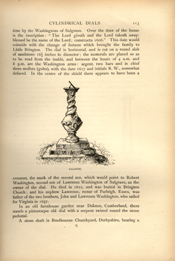
[Full Image]
DALSTON.
time by the Washingtons of Sulgrave. Over the door of the house is the inscription: "The Lord giveth and the Lord taketh away, blessed be the name of the Lord; constructa 1606." This date would coincide with the change of fortune which brought the family to Little Brington. The dial is horizontal, and is cut on a round slab of sandstone 16 ¼ inches in diameter; the numerals are placed so as to be read from the inside, and between the hours of 4 a.m. and 8 p.m. are the Washington arms; argent, two bars and in chief three mullets (gules), with the date 1617 and initials R.W., somewhat defaced. In the centre of the shield there appears to have been a crescent, the mark of the second son, which would point to Robert Washington, second son of Lawrence Washington of Sulgrave, as the owner of the dial. He died in 1622, and was buried in Brington Church; and his nephew Lawrence, rector of Purleigh, Essex, was father of the two brothers, John and Lawrence Washington, who sailed for Virginia in 1657.
In an old farmhouse garden near Dalston, Cumberland, there stands a picturesque old dial with a serpent twined round the stone pedestal.
A stone shaft in Bradbourne Churchyard, Derbyshire, bearing a

[Full Image]
ST. MARY'S, SCILLY.
horizontal dial of brass, has certain regimental badges cut on the cap, showing that the dial was set up by Captain Thomas Buckstone, who fought at Culloden in 1745. In the garden at Bradbourne Hall, the ancient seat of the Buckstone family, there is another dial entirely of stone, except the gnomon, dated 1740, and by the same maker.
A sun-dial in the Italian garden at Newstead Abbey, Notts, is mounted on a unique pedestal, viz., the white marble capital of a pillar brought from the Temple of Venus at Athens. The history of the capital is inscribed on the dial plate.
A stone pedestal of classic mouldings in the formal garden at Canon's Ashby, Northants, the seat of Sir Henry Dryden, Bart., bears a sun-dial with the Dryden arms engraved on it, and the maker's name, "Jones, Holborn." It is certainly of later date than the pedestal, which was set up about 1710, the garden having been laid out by Edward Dryden in 1700.
Dial plates are often found with coats-of-arms engraved on them, and are sometimes very fine specimens of the engraver's art. A beautiful eighteenth-century specimen is at West Wycombe Park, Bucks, bearing the arms of Lord Despencer of the day upon it. Another fine plate at Staverton Court, Gloucestershire, has the shield of Sir William Strachan, Bart., and the name of "Thomas Wright, Instrument maker to his Majesty George II." The Fortescue arms are found on the dial in Ripple Churchyard, Gloucestershire, with the name of the maker, "Nath: Witham, Chancery Lane, London."
The late Mr. Bridgeman Simpson brought a very beautifully engraved dial plate from Stoke Hall, Derbyshire, and placed it on a pedestal in his garden at Babworth Hall, Notts. Perhaps the designs on these plates are most often heraldic, but emblematic figures and arabesque patterns are sometimes found on them. Messrs. Barker, of Clerkenwell Road, have lately engraved a handsome plate on which the tables of the equation of time are disposed in separate columns, according to the months, between flowers appropriate to the different seasons of the year. The gnomons also can be made very ornamental, when pierced, or supported by scrollwork of graceful design.
There is great scope for the artist in the treatment of horizontal dials, both in the adornment of the plate and the sculpture of the pedestal, but we will not be led astray into these paths of art. One
more pedestal alone shall be noticed, and it is of a severely simple character.
In the first edition of "The Book of Sundials," published 1872, Mrs. Gatty wrote: "At St. Mary's, the largest of the Scilly Isles, and near the fort called 'Star Castle' (if we remember the spot where we sketched it), is an old cannon stuck upwards in the ground, and over its mouth a dial plate is fixed. What storms must have broken upon it in that tempestuous region! What hurricanes must have blown around! What dark nights covered it! And yet, whenever the sun shines, and cheerfully as if no disturbance ever reached it, the dial face becomes bright again, and the gnomon sends its shadow round the plate."
